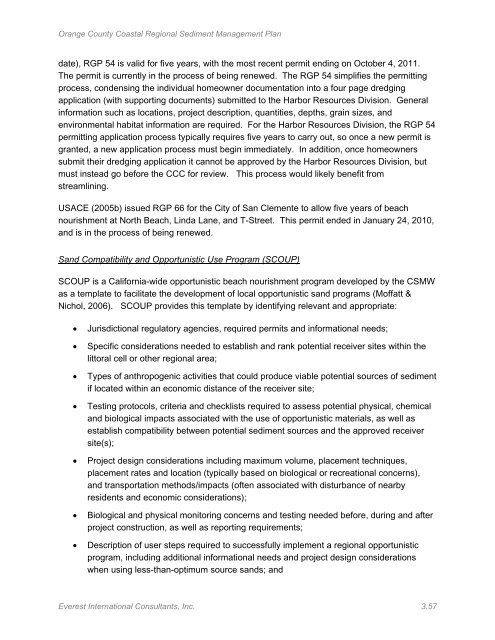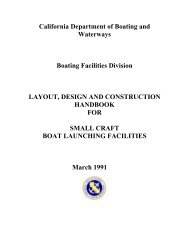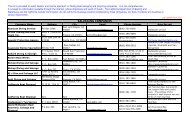EVEREST June, 2013 - California Department of Boating and ...
EVEREST June, 2013 - California Department of Boating and ...
EVEREST June, 2013 - California Department of Boating and ...
You also want an ePaper? Increase the reach of your titles
YUMPU automatically turns print PDFs into web optimized ePapers that Google loves.
Orange County Coastal Regional Sediment Management Plan<br />
date), RGP 54 is valid for five years, with the most recent permit ending on October 4, 2011.<br />
The permit is currently in the process <strong>of</strong> being renewed. The RGP 54 simplifies the permitting<br />
process, condensing the individual homeowner documentation into a four page dredging<br />
application (with supporting documents) submitted to the Harbor Resources Division. General<br />
information such as locations, project description, quantities, depths, grain sizes, <strong>and</strong><br />
environmental habitat information are required. For the Harbor Resources Division, the RGP 54<br />
permitting application process typically requires five years to carry out, so once a new permit is<br />
granted, a new application process must begin immediately. In addition, once homeowners<br />
submit their dredging application it cannot be approved by the Harbor Resources Division, but<br />
must instead go before the CCC for review. This process would likely benefit from<br />
streamlining.<br />
USACE (2005b) issued RGP 66 for the City <strong>of</strong> San Clemente to allow five years <strong>of</strong> beach<br />
nourishment at North Beach, Linda Lane, <strong>and</strong> T-Street. This permit ended in January 24, 2010,<br />
<strong>and</strong> is in the process <strong>of</strong> being renewed.<br />
S<strong>and</strong> Compatibility <strong>and</strong> Opportunistic Use Program (SCOUP)<br />
SCOUP is a <strong>California</strong>-wide opportunistic beach nourishment program developed by the CSMW<br />
as a template to facilitate the development <strong>of</strong> local opportunistic s<strong>and</strong> programs (M<strong>of</strong>fatt &<br />
Nichol, 2006). SCOUP provides this template by identifying relevant <strong>and</strong> appropriate:<br />
• Jurisdictional regulatory agencies, required permits <strong>and</strong> informational needs;<br />
• Specific considerations needed to establish <strong>and</strong> rank potential receiver sites within the<br />
littoral cell or other regional area;<br />
• Types <strong>of</strong> anthropogenic activities that could produce viable potential sources <strong>of</strong> sediment<br />
if located within an economic distance <strong>of</strong> the receiver site;<br />
• Testing protocols, criteria <strong>and</strong> checklists required to assess potential physical, chemical<br />
<strong>and</strong> biological impacts associated with the use <strong>of</strong> opportunistic materials, as well as<br />
establish compatibility between potential sediment sources <strong>and</strong> the approved receiver<br />
site(s);<br />
• Project design considerations including maximum volume, placement techniques,<br />
placement rates <strong>and</strong> location (typically based on biological or recreational concerns),<br />
<strong>and</strong> transportation methods/impacts (<strong>of</strong>ten associated with disturbance <strong>of</strong> nearby<br />
residents <strong>and</strong> economic considerations);<br />
• Biological <strong>and</strong> physical monitoring concerns <strong>and</strong> testing needed before, during <strong>and</strong> after<br />
project construction, as well as reporting requirements;<br />
• Description <strong>of</strong> user steps required to successfully implement a regional opportunistic<br />
program, including additional informational needs <strong>and</strong> project design considerations<br />
when using less-than-optimum source s<strong>and</strong>s; <strong>and</strong><br />
Everest International Consultants, Inc. 3.57




